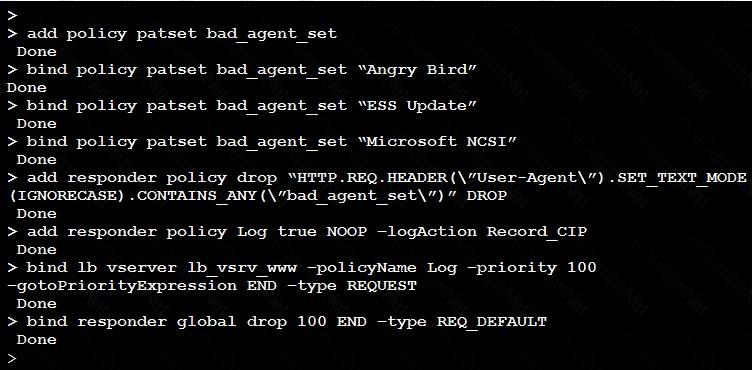Scenario: A Citrix Administrator created an SSL virtual server using only the following commands:
add lb vserver sslvserver SSL 10.102.29.133 444
add service sslsvc1 192.168.0.14 SSL 443
add service sslsvc2 192.168.0.15 SSL 443
bind lb vserver sslvserver sslsvc1
bind lb vserver sslvserver sslsvc2
set ssl vserver sslvserver –ssl3 disabled
The SSL virtual server is currently in a DOWN state.
What could be the reason the SSL virtual server is in a down state?
Scenario: A NetScaler receives packets that are destined for a MAC address owned by the NetScaler. The destination IP address of the packets does NOT belong to the NetScaler. Layer 3 Mode is enabled by default on the NetScaler.
What will the NetScaler do with the packets in this scenario?
Which mode does a Citrix Administrator need to configure in order to allow the NetScaler to forward any packets that are NOT destined for an IP address that is NOT configured on NetScaler?
Scenario: A Citrix Administrator is performing a disaster recovery test and decided to fail over the NetScaler high availability (HA) pair appliances. The administrator noticed that the failover is NOT working as expected in item text, and the Secondary NetScaler is NOT taking over as Primary. The administrator suspects that networking issues may be causing the failure.
What could be the cause of this issue with the NetScalers?
Click the “Exhibit” button to view the screenshot.

How will the HTTP request “http://xenapp.training.lab/url1” be redirected based on the screenshot?
Scenario: A Citrix Administrator configured the HTTP_Callout feature on the NetScaler using the command-line interface.
After configuring the commands, the device is facing the HTTP callout recursion issue.
Click on the ‘Exhibit’ button to view the screenshot of the command-line interface.

How will the administrator rectify the issue?
Scenario: A Citrix Administrator used the commands in the screenshot to apply the user-agent check to all the virtual servers. However, the administrator observed that it is NOT being applied to the vServer lb_vsrv_www.
Click on the ‘Exhibit’ button to view the screenshot of the command-line interface.

What can be causing this issue?
In the Global Server Load Balancing (GSLB) configuration when dynamic proximity is implemented, the round trip time (RTT) between the _____________ and _____________ is measured to make the load decision. (Choose the correct option to complete the sentence.)
Scenario: A Citrix Administrator has made changes to the NetScaler, deleting parts of the configuration, and then saved the new configurations. The changes caused an outage which needs to be resolved as quickly as possible. There is no NetScaler backup.
What does the administrator need to do to recover the configuration quickly?
Which scenario will cause automatic high availability (HA) synchronization to fail?
Scenario: A NetScaler is configured with Interface 1/1 and bound to VLAN 40. A Citrix Administrator has executed the following command:
bind vlan 20 –ifnum 1/1
What is the result of executing the command on the NetScaler?
A Citrix Administrator is configuring Unified Gateway with authentication policies.
Where should the administrator configure NetScaler Gateway authentication policies?
What is the effect of the set csv server vserver-CS-1 –redirectURL http://www.newdomain.com/mysite/ command?
Which utility can a Citrix Administrator use to resolve the Domain Name System (DNS) request being looked up frequently?
Scenario: A Citrix Administrator currently manages a NetScaler environment in a retail company that is growing quickly and may soon double its volume of business. Currently, a NetScaler MPX 5550, which handles web and SSL transactions, is in place, but is close to full capacity. Due to the forecasted growth increase, the administrator needs to find a cost-effective solution.
What can the administrator recommend to management in order to cost effectively handle the growth?
A Citrix Administrator is configuring a NetScaler high availability (HA) pair and needs to ensure that one Net Scaler is UP and primary at all times to ensure the business websites are always available.
What does the administrator need to do to ensure that the NetScalers still handle web traffic in the event that both nodes become unavailable or fail a health check?
Scenario: A Citrix Administrator is configuring SNMP management on the NetScaler to receive alerts when something fails. The administrator was confident that the Manager, Alarms and SNMP Traps were configured correctly. The following week, there was a NetScaler-related outage and the administrator did NOT get any alerts.
What could be the reason for the SNMP alert failure?
What is the first thing a Citrix Administrator should create when creating a Server Certificate for NetScaler to secure traffic?